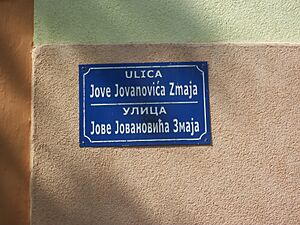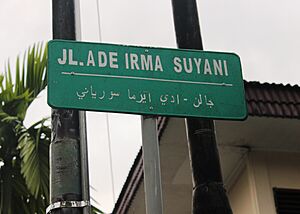Digraphia facts for kids
Imagine a language that can be written in more than one way! That's what digraphia means. It's when a single language uses different writing systems.
Sometimes, these different writing systems are used at the same time. This is called synchronic digraphia. Think of it like having two different keyboards for the same language. Other times, a language changes its writing system over many years. This is called diachronic digraphia. It's like upgrading from an old keyboard to a new one. Understanding digraphia helps us see how languages change and how people choose to write them.
Contents
What is Digraphia?
The word "digraphia" comes from ancient Greek. "Di-" means "twice," and "-graphia" means "writing." So, it literally means "two writings." It's similar to another word, "diglossia," which means a community uses two different languages or dialects.
For example, the Hindustani language is a great example of synchronic digraphia. It has two main forms: Urdu, written with the Urdu alphabet (which looks like Arabic script), and Hindi, written with Devanagari script. Both are the same language, but they look different when written!
A famous example of diachronic digraphia is Turkish. Before 1928, Turkish was written using the Arabic script. But then, it switched to a Latin alphabet-based system. This was a big change in how the language looked on paper.
Why Do Languages Use Different Scripts?
Why would a language have more than one way to write it? There are many reasons why people choose or change a writing system.
- To show who they are: Sometimes, a community chooses a script to connect with a certain group or culture. For instance, in the 1940s, Mongolian changed its script to Mongolian Cyrillic alphabet because of Soviet influence. Later, the traditional Mongolian script was brought back to celebrate their history.
- To be different: On the other hand, a group might use a unique script to stand out from others. In the 1800s, a group in the US created the Deseret alphabet for English. They said it was better for sounds, but it also helped them feel distinct.
- To connect with the world: Choosing a script can help a group interact with other countries. The Hmong language has several writing systems. Hmong people in Southeast Asia might use the Romanized Popular Alphabet, while those living abroad might use a different Latin-based way to write their names.
- Because it fits the sounds better: Sometimes, a script just works better for a language's sounds. The Korean language was first written with Chinese characters (called Hanja). But King Sejong the Great created the Korean alphabet (called Hangul in South Korea, or Chosŏn'gŭl in North Korea). This new alphabet was much better for writing Korean sounds.
- Special uses: Sometimes, different scripts are used for special purposes. For example, in Japanese, women historically used hiragana more often. The famous book The Tale of Genji was written this way. Also, some heavy metal bands use special letters like umlauts (e.g., Motörhead) to give their names a certain look and feel.
Languages Using Multiple Scripts Now (Synchronic Digraphia)
Many languages around the world use more than one writing system at the same time.
- Serbo-Croatian: This language is spoken in several countries. People who are Catholic (like in Croatia) or Muslim (like in Bosnia) often use the Gaj's Latin alphabet. Orthodox Christians (like in Serbia and Montenegro) usually use the Serbian Cyrillic alphabet. Most people can read both!
- Japanese: This is a very interesting case! Japanese uses three main scripts:
Sometimes, they even use rōmaji (Latin letters) for things like brand names.
- Hindustani: As we mentioned, Hindi uses Devanagari and Urdu uses the Urdu alphabet. Even though they are the same language, their written forms look very different.
- Malay: This language is often written with the Latin alphabet. But in places like Brunei and parts of Malaysia, it's also written using Jawi script, which is an adapted Arabic alphabet.
- Javanese: On the island of Java in Indonesia, the Javanese language has a traditional script called Hanacaraka. After Islam arrived, a modified Arabic script called Pegon script was used. Then, with European influence, the Latin alphabet became common. So, Javanese can be written in three different ways today!
- Chinese: In Written Chinese, there's a discussion about using both Chinese characters and Hanyu Pinyin (a way to write Chinese sounds with Latin letters). Pinyin is used for learning Chinese, typing on computers, and for some labels. Many experts believe Pinyin will become even more important for Chinese in the future.
- Other examples:
- Inuktitut (spoken by Inuit people) uses both Latin and Inuktitut syllabics.
- Punjabi uses Gurmukhi in India and Shahmukhi (Perso-Arabic) in Pakistan.
- Kashmiri can be written in Sharada script, Devanagari, Nastaliq, and Latin.
- Konkani uses five scripts: Devanagari, Kannada script, Latin, Malayalam, and Perso-Arabic.
- Uzbek uses both Cyrillic and Latin scripts, especially online and in print.
Languages That Changed Scripts Over Time (Diachronic Digraphia)
Sometimes, a language completely switches from one writing system to another. This can happen slowly over centuries or very quickly due to big changes.
- Turkish: A famous example is Turkish. In 1928, under the leadership of Mustafa Kemal Atatürk, Turkey switched from using the Arabic script to a Latin alphabet in just one year!
- Korean: The change from writing Korean with Chinese characters (Hanja) to the unique Korean alphabet (Hangul) took hundreds of years. It was a gradual process.
- Romanian: This language used to be written with the Cyrillic alphabet until the 1860s, when it switched to the Latin alphabet.
- Vietnamese: The Vietnamese language once used a form of Chinese writing called Chữ Nôm. Now, it is written using the Latin alphabet.
- Former Soviet Countries: After the Soviet Union dissolved, many countries that had used the Cyrillic script switched to the Latin alphabet. Examples include Moldova, Azerbaijan, Turkmenistan, and Uzbekistan.
- Azerbaijani: This language has changed its script many times throughout history! It has been written in Old Turkic script, Arabic, Latin, Cyrillic, and is now back to Latin.
- Kazakh: In Kazakhstan, the Kazakh language is currently written in Cyrillic. However, the country is in the process of switching to the Latin script in 2025.
- Mongolian: As of 2025, the Mongolian government has made the traditional Mongolian script co-official with the Cyrillic script that was used before.
- Malay: While Malay uses Jawi in some places (synchronic), it has largely replaced Jawi with the Latin alphabet over time, making it also an example of diachronic digraphia.
See also
- Official script
- Diglossia




